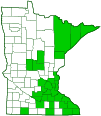European cranberrybush
(Viburnum opulus var. opulus)
Conservation • Wetland • Description • Habitat • Ecology • Use • Distribution • Taxonomy
Description |
||
European cranberrybush is a relatively fast-growing, short-lived, tall shrub. It can be up to 20′ tall and up to 2⅜″ in diameter at breast height, but is usually no more than 12′ in height. It rises on multiple stems from scattered, deep, anchoring roots and shallow, spreading, fibrous, soil-binding roots. Shrubs reproduce vegetatively by layering or tip rooting. In layering, shrubs produce stems that lie on the ground with only the tips ascending (decumbent). A decumbent stem roots at a node, produces an aerial stem, and eventually detaches, forming a new plant. In addition, lower branches may droop to the ground, root at the tip, and send up a new shoot. Vegetative reproduction occasionally results in a thicket. The stems are upright, slightly spreading, or sometimes arching. Twigs are moderately stout. First year twigs are green to reddish-green and hairless, with white, conspicuously raised bumps (lenticels). Second-year twigs are yellowish-brown to grayish-brown, round in cross section, and hairless, with widely scattered, small, round lenticels. The pith is white and solid. The leaf scars are narrow, crescent-shaped, and slightly raised. Each leaf scar has three bundle scars. The terminal bud is stalked, greenish-red, mostly hairless, short, plump, oblong egg-shaped, and somewhat flattened. It is not sticky. It is covered by two scales that are fused into a tube at the base and for part of their length, free and overlapping toward the tip. Lateral buds are about half as long and globe-shaped to egg-shaped. The bark is gray or grayish-brown, relatively smooth, and not peeling. On older stems the bark occasionally becomes somewhat fissured. The leaves are opposite, undivided (simple), and deciduous. They are attached to the twig on a ¾″ to 1 3 ⁄16″ long leaf stalk (petiole). The petiole is green or greenish-red and channeled on the upper (ventral) side. It is hairless or may have some scattered short, fine hairs near the tip. It is not winged. There are 2 or 4 projecting, 1 ⁄32″ to 1 ⁄16″ in diameter glands near the attachment of the leaf blade. The glands are stout, elliptical in cross section, and indented (concave) on the top with a conspicuous ear-like rim. There is a pair of leaf-like, brislty, 1 ⁄32″ to 3 ⁄16″ in long appendages (stipules) at the base of the petiole. The stipules persist for most of the growing season. The glands may disappear or become deformed late in the season. The leaf blades are relatively thin, papery (firm), broadly egg-shaped in outline, shallowly to moderately 3-lobed, 1⅜″ to 3⅛″ long and wide. They are broadly rounded, broadly tapered, or nearly squared off at the base. The lobes are angled or short-tapered to a sharply-pointed tip. The leaf blades are palmately veined with three main veins, each one extending from the petiole at the base of the blade to the tip of one of the lobes. Each main vein has several pinnate secondary veins. The secondary veins are straight or slightly arched, and most reach the margin and end in a tooth. The veins are depressed on the upper surface of the blade, raised on the lower surface. The upper surface is dark green, has a slightly wrinkled appearance, and is hairless or almost hairless. The lower surface is pale green and moderately to densely hairy especially along the main veins. The margins are coarsely toothed with 3 to 7 teeth per inch, 3 to 7, sometimes to 9, teeth on each side of each lobe. Leaves near the branch tips are often narrow and unlobed. The leaves turn yellow, orange, red or dark reddish-purple in the fall. The inflorescence is a dense, rounded, flat-topped, 2″ to 5″ in diameter, branched cluster (cyme). It is borne on a ⅝″ to 2″ long stalk (peduncle) at the end of a four-leaved shoot that rises from a lateral bud at the end of a second-year twig. The cymes have 6 to 8 main branches emanating from the tip of the shoot. Each cyme has 100 or more small fertile flowers and an outer ring or 5 to 10 much larger sterile flowers. The fertile flowers are ⅛″ to ¼″ in diameter. There are five sepals, five petals, five stamens, and one style. The sepals are green, fused for most of their length into a minute cup (calyx), and separated at the tip into five minute, egg-shaped lobes. The petals are pale yellow to creamy white, egg-shaped to elliptical, and 1 ⁄16″ to ⅛″ long. The stamens have white filaments and bright yellow anthers. They are 1 ⁄16″ to ⅛″ long, longer than the petals. The style is thick, short, light green, and tipped with a three-lobed stigma. The sterile flowers on the margin are flat and ½″ to 1″ in diameter. The flowers have an unpleasant scent. They appear in late May to late June after the leaves. The fruit arrangement (infructescence) is a heavy, drooping cluster. Each fruit is a juicy, cranberry-like, ellipse-shaped to nearly spherical, ¼″ to ⅜″ in diameter drupe. It contains one seed. It is green initially, turning yellowish as it matures, eventually becoming translucent orange or bright red when ripe. The calyx and stigma persist in fruit, forming a dried tip at the end (apex) of the drupe. The peduncles turn red as the fruit matures. The fruit ripens in early to late August, often remaining on the plant through the winter. It is edible but bitter mildly toxic. |
||
Height |
||
3′ to 20′ |
||
Flower Color |
||
White |
||
Similar Species |
||
American highbush cranberry (Viburnum opulus var. americanum) leaf petioles have no more than 4 projecting glands. The glands are smaller, round in cross section, and flat or convex on the top. They do not show an ear-like rim. The channel on the petiole has relatively long, coarse hairs. The leaves are larger, up to to 4¾″ long and 4⅜″ wide. The leaf margins are untoothed or sparingly toothed. The drupes are tart, not bitter. |
||
Habitat |
||
Moist to wet. Deciduous woodland openings and edges; thickets; streambanks. Full sun to light shade. |
||
Ecology |
||
Flowering |
||
Late May to late June |
||
Pests and Diseases |
||
|
||
Toxicity |
||
The fruit is edible in small quantities but is mildly toxic. It may cause vomiting and diarrhea if large amounts are eaten. |
||
Use |
||
Horticulture |
||
European cranberrybush is sold in nurseries as “high-bush cranberry”. |
||
Distribution |
||||
|
Sources |
|||
| 2/12/2023 | ||||
Nativity |
||||
Native to Europe and Asia. Introduced, cultivated, escaped cultivation, and now naturalized in North America. |
||||
Occurrence |
||||
|
||||
Taxonomy |
|||
| Kingdom | Plantae (Plants) | ||
| Division | Tracheophyta (Vascular Plants) | ||
| Subdivision | Spermatophytina (Seed Plants) | ||
| Class | Magnoliopsida (Dicots) | ||
Order |
Dipsacales (honeysuckles, moschatels, and allies) | ||
Family |
Viburnaceae (elder) | ||
Genus |
Viburnum (viburnums) | ||
| Species | Viburnum opulus (Guelder rose) | ||
Family Currently (2023), some sources, including USDA PLANTS and NatureServe, place the genera Sambucus and Viburnum in the Caprifoliaceae family. Some sources, including ITIS and NCBI, place them in the Adoxacea family. Almost all other sources, including APG IV, World Flora Online, Plants of the World Online, GRIN, GBIF, and iNaturalist, place the two genera in the Viburnaceae family. |
|||
Subordinate Taxa |
|||
|
|||
Synonyms |
|||
Viburnum roseum Viburnum opulus ssp. opulus Viburnum opulus var. roseum |
|||
Common Names |
|||
crampbark European cranberry-bush European cranberrybush Guelder rose Guelder-rose snowballbush |
|||
European cranberrybush is a deciduous shrub, not a true cranberry (Vaccinium Oxycoccos), which is an evergreen dwarf shrub. |
|||
Glossary
Calyx
The group of outer floral leaves (sepals) below the petals, occasionally forming a tube.
Cyme
A branched, flat-topped or convex flower cluster in which the terminal flower opens first and the outermost flowers open last.
Decumbent
Reclining on the ground but with the tips ascending.
Drupe
A fleshy fruit with a single hard, stone-like core, like a cherry or peach.
Layering
A method of propagation where a stem or branch comes into permanent contact with the soil, sprouts roots, and then detaches from the main plant.
Lenticel
A corky, round or stripe-like, usually raised, pore-like opening in bark that allows for gas exchange.
Palmate
Similar to a hand. Having more than three lobes or leaflets that radiate from a single point at the base of the leaf.
Peduncle
In angiosperms, the stalk of a single flower or a flower cluster; in club mosses, the stalk of a strobilus or a group of strobili.
Petiole
On plants: The stalk of a leaf blade or a compound leaf that attaches it to the stem. On ants and wasps: The constricted first one or two segments of the rear part of the body.
Pinnately veined
With the veins arranged like the vanes of a feather; a single prominent midvein extending from the base to the tip and lateral veins originating from several points on each side.
Pith
The spongy cells in the center of the stem.
Simple leaf
A leaf that is not divided into leaflets, though it may be deeply lobed or cleft.
Stipule
A small, leaf-like, scale-like, glandular, or rarely spiny appendage found at the base of a leaf stalk, usually occurring in pairs and usually dropping soon.
Winged leaf stalk
A leaf stalk with a leaf-like or membrane-like extension along both sides.
Visitor Photos |
|||||
Share your photo of this plant. |
|||||
| This button not working for you? Simply email us at info@MinnesotaSeasons.com. Attach one or more photos and, if you like, a caption. |
|||||
Kirk Nelson |
|||||
shrub |
|||||
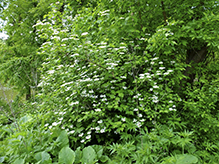 |
|||||
bark |
|||||
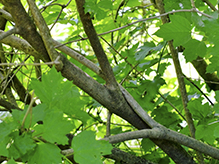 |
|||||
glands |
|||||
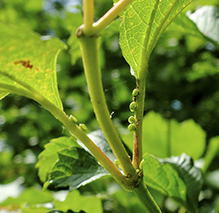 |
|||||
flowers |
|||||
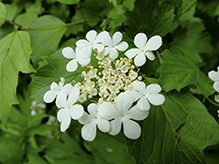 |
|||||
fruit |
|||||
 |
|||||
MinnesotaSeasons.com Photos |
|||||
Plant |
|||||
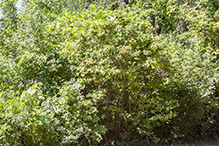 |
|||||
Leaves |
|||||
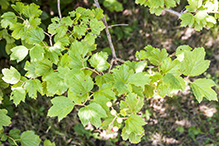 |
|||||
Glands on Petiole |
|||||
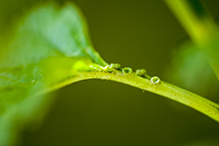 |
|||||
Infructescence |
|||||
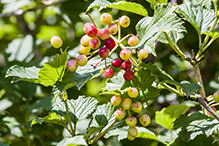 |
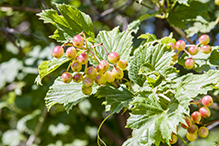 |
||||
Fruit |
|||||
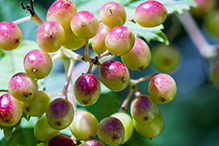 |
|||||

Visitor Videos |
|||
Share your video of this plant. |
|||
| This button not working for you? Simply email us at info@MinnesotaSeasons.com. Attach a video, a YouTube link, or a cloud storage link. |
|||
Other Videos |
|||
| Guelder Rose (Viburnum opulus) - 2012-10-06 W3stlander |
|||
About
Published on Oct 9, 2012 Viburnum opulus (Guelder Rose, Water Elder, European Cranberrybush, Cramp Bark, Snowball Tree) is a species of Viburnum, native to Europe and Asia. --------------- 52.01788 4.32096 |
|||
| Viburnum opulus 2 wander van laar |
|||
About
Published on Aug 23, 2014 Viburnum opulus of Gelderse roos is een inheemse bladverliezende heester die het liefst op een vochthoudende bodem staat. De bloei van Viburnum opulus valt in de periode mei-juni. De witte schermvormige bloemen van Viburnum opulus hebben een diameter van 5 tot 10 cm. Na de bloei vormt Viburnum opulus talrijke rode (giftige) bessen van ongeveer een cm groot. Google Translation Viburnum opulus or Guelder Rose is a native deciduous shrub that state prefers a moist soil . The flowering Viburnum opulus falls in the period May-June. The white screen -shaped flowers of Viburnum opulus have a diameter of 5 to 10 cm. After flowering is Viburnum opulus numerous red (poisonous ) berries of about one cm. |
|||
| viburnum opulus zebrablu |
|||
About
Uploaded on Aug 14, 2011 z |
|||

|
Created: Last Updated: © MinnesotaSeasons.com. All rights reserved. |
